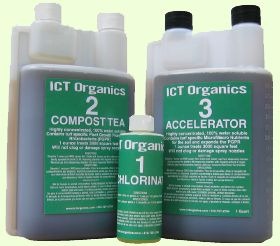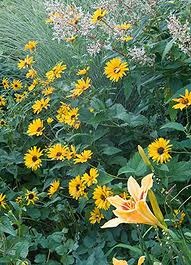Are you looking for answers to organic lawn care? Do you want to prepare your lawn for organic lawn care next year when you winterize it this fall?
Try Instant Compost Tea!
Keep reading if you want to know why this works so well.
Why apply compost tea?
The point of applying compost tea is to return the biology to the soil that should be present. This enables you to grow plants, grass or your favorite tomato with as little effort as possible.
Beneficial bacteria and fungi are needed in the soil to make nutrients available to the plants. It also prevents erosion by gluing and binding soil particles together to form aggregates
What are the benefits of spraying compost teas?
Benefits include:
· increased nutrient water absorption
· increased water absorption
· nutrient mobilization
· increase in feeder root longevity
· accumulation of nitrogen, phosphorous, potassium, calcium, zinc and their translocation to the host tissue
· minerals get mobilized in F and H horizons before they reach the sub soil system
· provide the host plant with growth hormones like auxins, cytokinins, gibberellins and growth regulators such as Vitamin B
· plays a significant role in nutrient cycling and the entry of the fungi biomass into soil organic matter pool.
Can compost tea supply the nutrients to the soil that plants and grasses need?
The surprising answer to that question is yes. Not in the standard “fertilizer” form (nitrate) however, but as organic N, held by the biology in organic matter and microbial, biological forms.
Is compost tea a fertilizer?
Most people have been told that compost tea is not a fertilizer. That statement can be made if only soluble, inorganic nutrients are used. The fertilizer industry has pushed to define N as only nitrate, possibly nitrite and maybe ammonium, the inorganic forms of Nitrogen. While this is based on the soluble forms of Nitrogen that most vegetable and row crops take up through their roots, it is far from the only source of Nirogen in the soil.
Nitrogen enters the soil in organic forms such as plant roots, leaves, and other plant materials, in addition to dead animals, insects, and microorganisms, manure, and compost. As these decompose, the once recognizable plant and animal materials are transformed into soil organic matter called humus which contains organic nitrogen. Living plants cannot use these organic forms of Nitrogen. This is why microbes living in the soil are so important, because they convert organic Nitrogen into forms of Nitrogen that plants can then use.
If the full soil web is present, then forms of Nitrogen that are not nitrate, nitrite or ammonium will be cycled into these soluble forms by the organisms. And not just Nitrogen, but any non-soluble form of any nutrient will eventually be converted from its non-soluble form to the plant available, soluble form by the organisms cycling system in a healthy soil.
Natural systems do not require the additions of inorganic, soluble (and thus very leachable) forms of nutrients to maintain soil and plant health. The most productive systems on this planet are systems which do not have, and have not ever had, inorganic fertilizer applied,
The good guys in the soil
Bacteria
There are typically 40 million bacterial cells in a gram of soil and a million bacterial cells in a milliliter of fresh water; in all, there are approximately five nonillion (5×1030) bacteria in the world. Bacteria are vital in recycling nutrients, and many important steps in nutrient cycles depend on bacteria, such as the fixation of nitrogen from the atmosphere.
Bacteria occupy most of the leaf and/or root surface and thus are effective at consuming the food resource that the disease causing organisms would otherwise consume. In soil, bacteria have additional function beyond consuming; they also retain nutrients (N, P, S, Ca, Fe, etc.) in their bio-mass. Bacteria also decompose plant-toxic materials and plant residues and build soil structure. The smallest building blocks of soil structure are built by beneficial bacteria. Without these bacteria, the bricks to make the “soil house” will not occur and further development of soil structure will not happen. If the organisms are not present, water holding capacity cannot be improved. Most of the bacteria in the compost tea will not be the right ones at the moment you apply the tea, so they go to sleep in the soil, and wait for the right conditions that will allow them to wake up, suppress their competitors, retain nutrients, decompose residues and build soil aggregate structure.
Protozoa
Protozoa eat bacteria, releasing nutrients that stimulate growth of bacteria, fungi and plants, if plants are present. So, when scientists say “bacteria mineralizes N in soil”, what is really happening is that protozoa mineralize N as they consume bacteria.
The organically maintained landscape.
In natural systems, organic matter generally cycles in place, added to the soil through root and stem decay of winter killed annuals and leaf decay. A thriving microbial community digests and breaks down this organic matter to release nutrients back to the soil. Organic soil amendments may be needed to help balance the soils chemistry, stimulate its biology, and restore its physical composition. Such amendments may also be needed to feed turf grass in a lawn, which has extraordinary nutrient needs because it is grown in an unnatural way, perpetually mowed and kept green as long as possible.
NPK and Inorganic Fertilizers
Lawn and landscape care methods which directly feed the plant with synthetic nitrogen-phosphorous-potassium (NPK) lead to damage to the soil and a weak root system, making the turf grass or plants in the landscape more susceptible to insects, disease and drought. Over fertilizing the turf grass or plant will also inhibit the development of mycorrhizae, a symbiotic fungi growing on or around the plant roots that help gather nutrients beyond the range of the root themselves. Eventually the soil structure collapses and becomes infertile.
Leaching
Like the negative end of a magnet, nitrogen in the form of nitrate is negatively charged and is not attracted to soil’s negatively charged clay and humus. Negatively charged clay repels negatively charged nitrite (NO2) and nitrate (NO3) so they will not be absorbed by the clay and are left to move down through the soil and into the groundwater, where streams and drinking water can become contaminated.
Reviving collapsed soil structure.
To revive dead, compacted soil, it will necessary to apply compost and compost tea to improve and build soil life.
A well balanced soil fertility program that increases humus content, organic matter and beneficial microorganisms recycles nutrients, improves water retention, balances minerals and buffers PH. In addition to compost, organic matter (manure) and compost tea other amendments may be indicated based on soil test results. These include natural surfactants to aerate soil, root stimulants and developers, rock dust, secondary and micronutrients, flocculants, vitamins, beneficial microbes, enzymes, organic humus, fulvic acid, kelp or dextrose.
What is nitrogen (N)?
Nitrogen is an essential macronutrient because it is required to create amino acids and proteins, genetic material, chlorophyll and other important biochemical molecules. Nitrogen is the most abundant gas in the atmosphere (78%) but the gaseous form (N2) is inert and unavailable for use by animals and most plants. Turning N2 into available nitrogen or “fixing” it, requires breaking the bond between the nitrogen atoms which requires energy. Under natural conditions nitrogen is fixed by lightning strikes through the atmosphere and by the work of a few species of symbiotic bacteria and some free-living bacteria and fungi in the soil or water. As part of the symbiotic relationship, the plant subsequently converts the ammonium ion to nitrogen oxides and amino acids to form proteins and other biologically useful molecules, such as alkaloids. In return for the usable (fixed) nitrogen, the plant secretes sugars to the symbiotic bacteria.
What is Phosphorous? (P)
Phosphorous, in the form of phosphate, is an essential macronutrient – it is a vital part of the cellular energy transfer. Phosphorous is added to soils in natural systems by rock weathering. Leaching and runoff removes phosphorous from the soils, where it is carried to aquatic systems like aquifers, streams, lakes and bays. In fresh water aquatic systems excess phosphorous can substantially increase plant productivity and lead to eutrophic conditions (lack of oxygen), causing increased phytoplankton and bacterial growth, loss of dissolved oxygen and loss of animal life in the system.
What is Potassium? (K)
It is primarily used in fertilizers as either the chloride, sulfate or carbonate – not as the oxide. Potassium is an essential component needed in plant growth and is found in most soil types. Potassium has two roles in the functioning of plant cells. First, it has an irreplaceable part to play in the activation of enzymes which are fundamental to metabolic processes, especially the production of proteins and sugars. Only small amounts of potassium are required for this biochemical function.
Second, potassium is the “plant-preferred” ion for maintaining the water content and hence the turgor (rigidity) of each cell, a biophysical role. A large concentration of potassium in the cell sap creates conditions that cause water to move into the cell (osmosis) through the porous cell wall. Turgid cells maintain the leaf’s vigor so that photosynthesis proceeds efficiently.
Plants are apparently unable to regulate the uptake of potassium; and if the soil supply is high enough, a so called luxury consumption may result. Under such conditions, the high potassium content in the grass plant may cause an excessive amount of stiffness in the stems and leaves as well as other undesirable or harmful effects.
NPK note: Commercial preparations of fertilizers have a somewhat misleading labeling system. It is often said that the three main numbers listed is the amount of Nitrogen, Phosphorus, and Potassium in the product. This is NOT the case. You must read the label carefully. If you read carefully, you will find that the last number is the percentage of Soluble Potash – NOT Potassium – expressed as K20.
Treat, Condition, Detoxify, and Improve Your Soil!
Get Your Soil Ready for the Switch to Organic.
Visit our website for more information, tips and products



